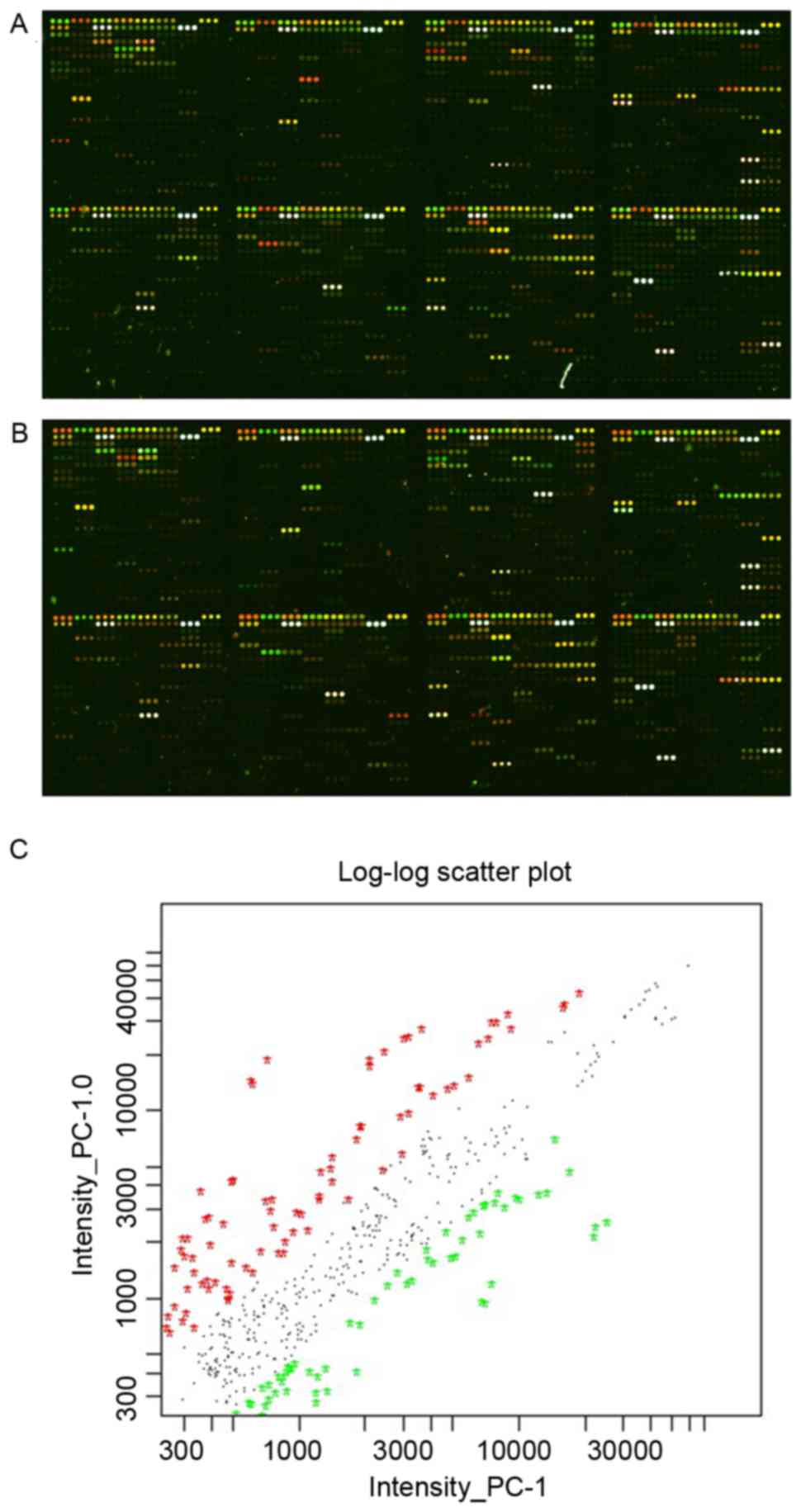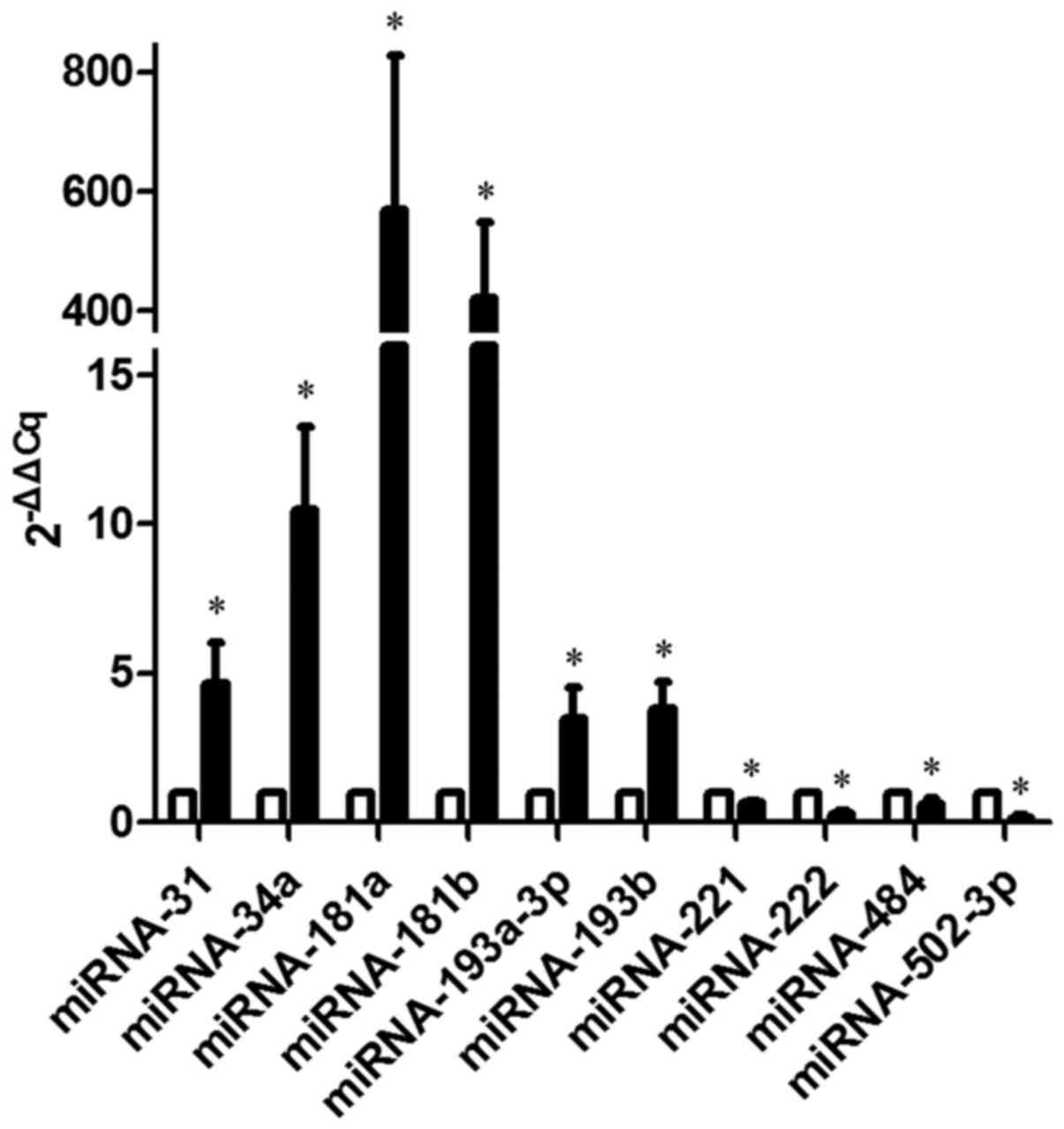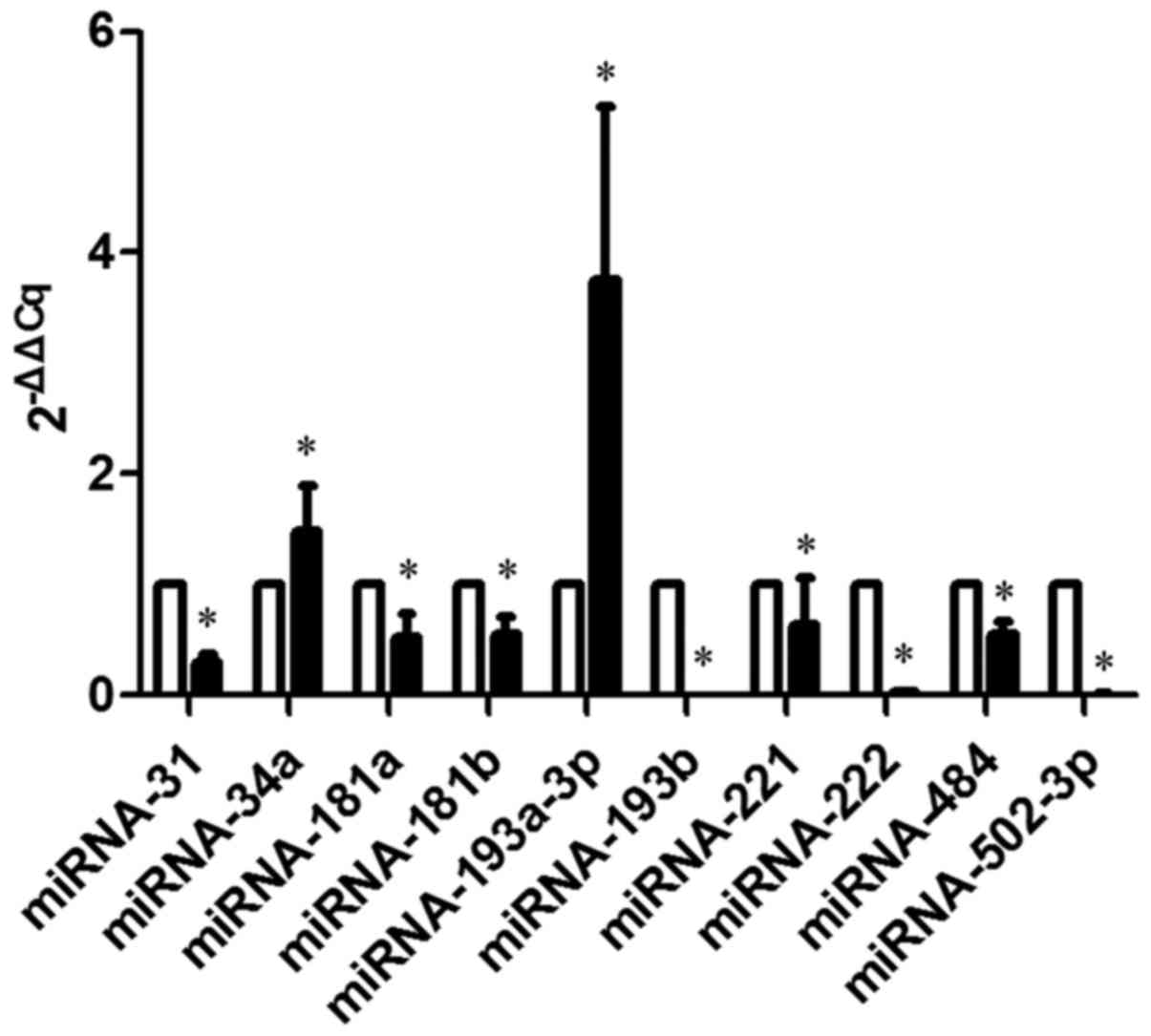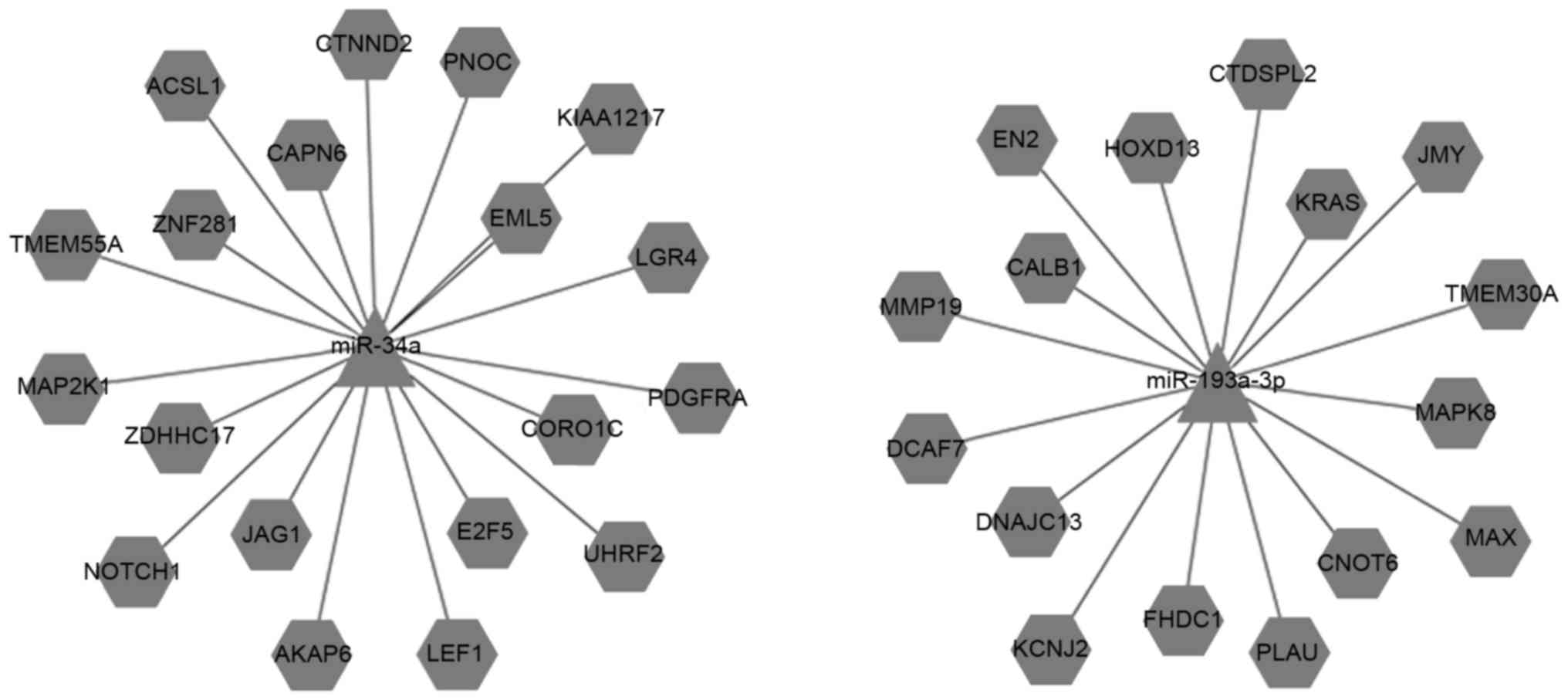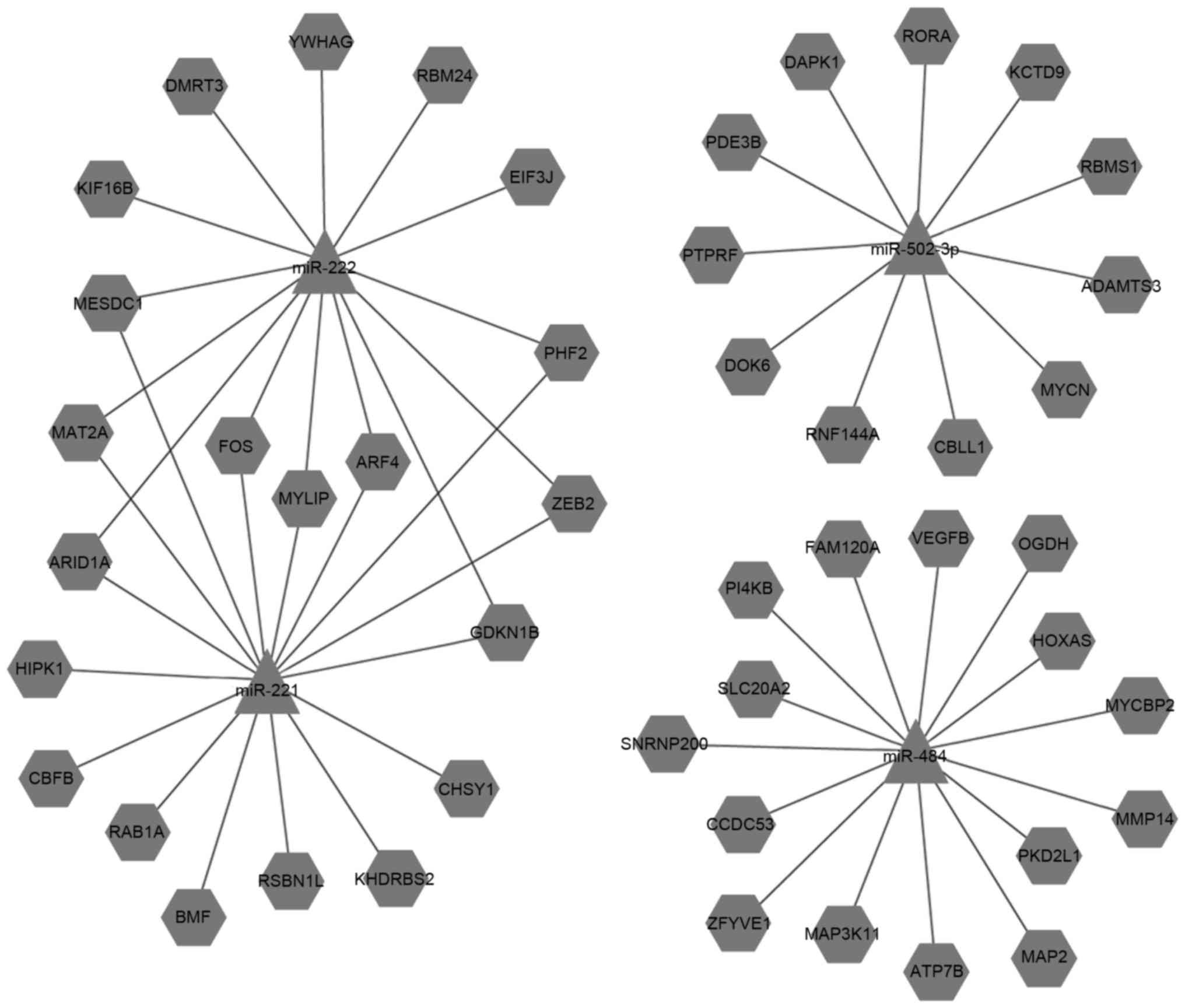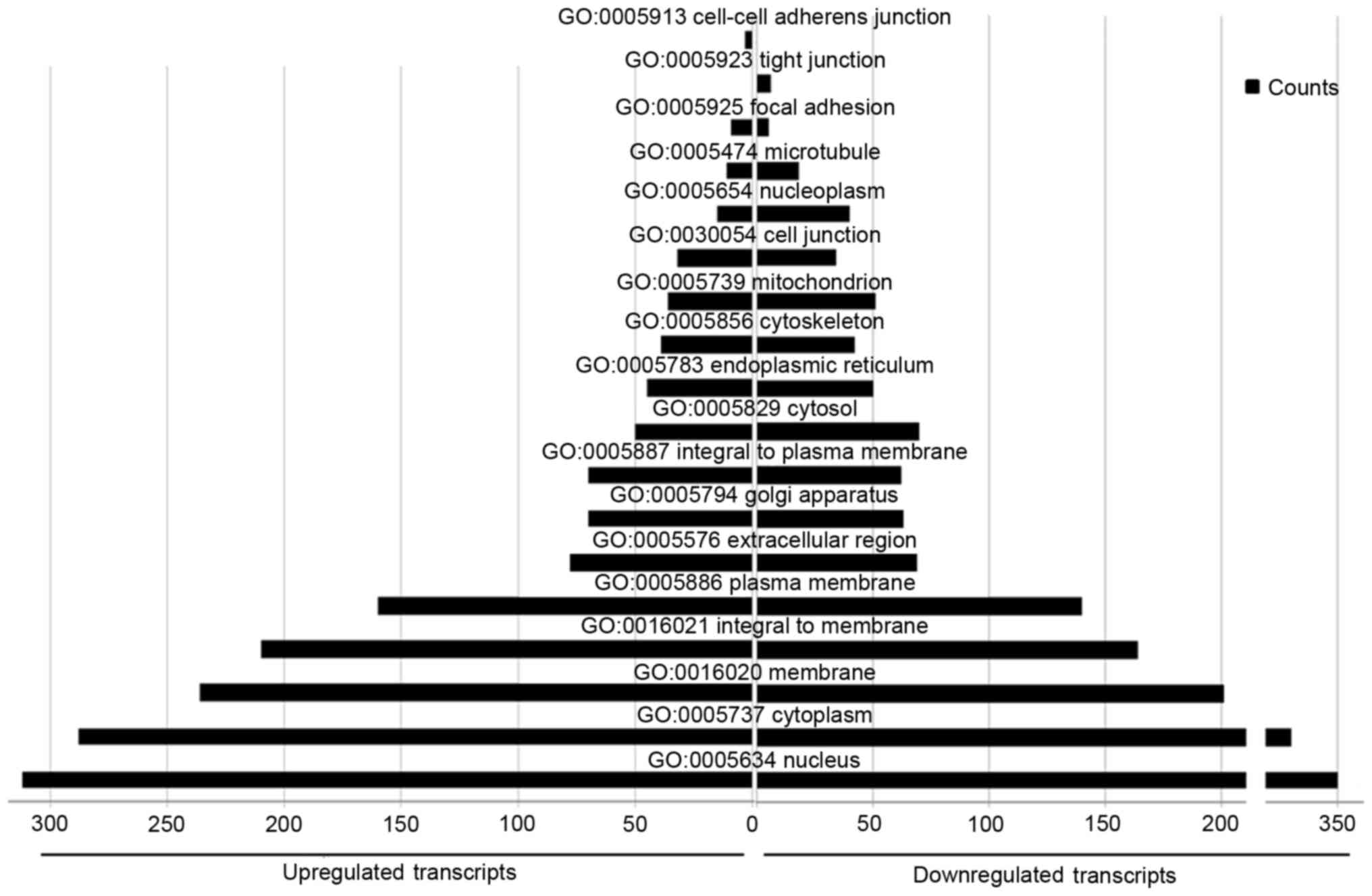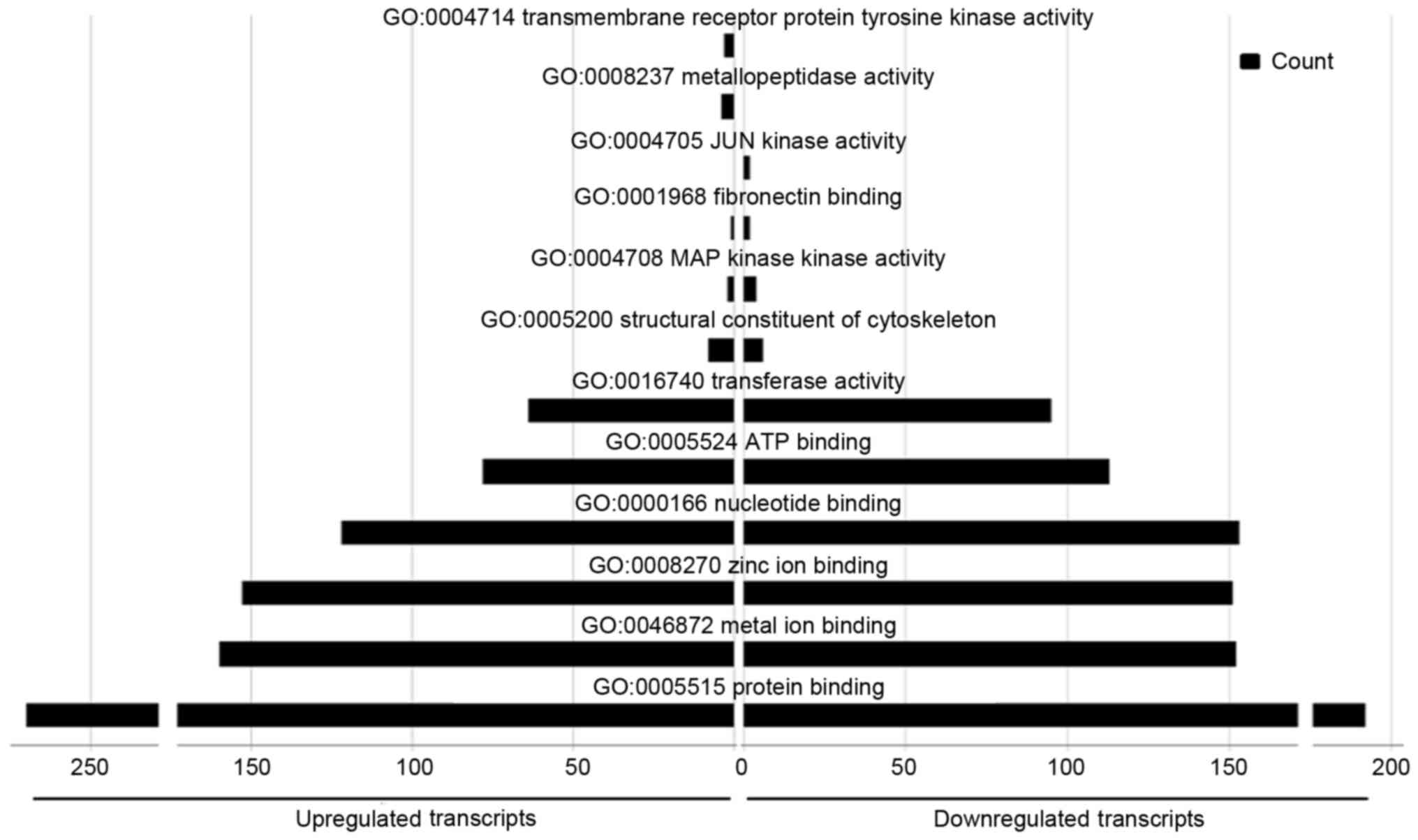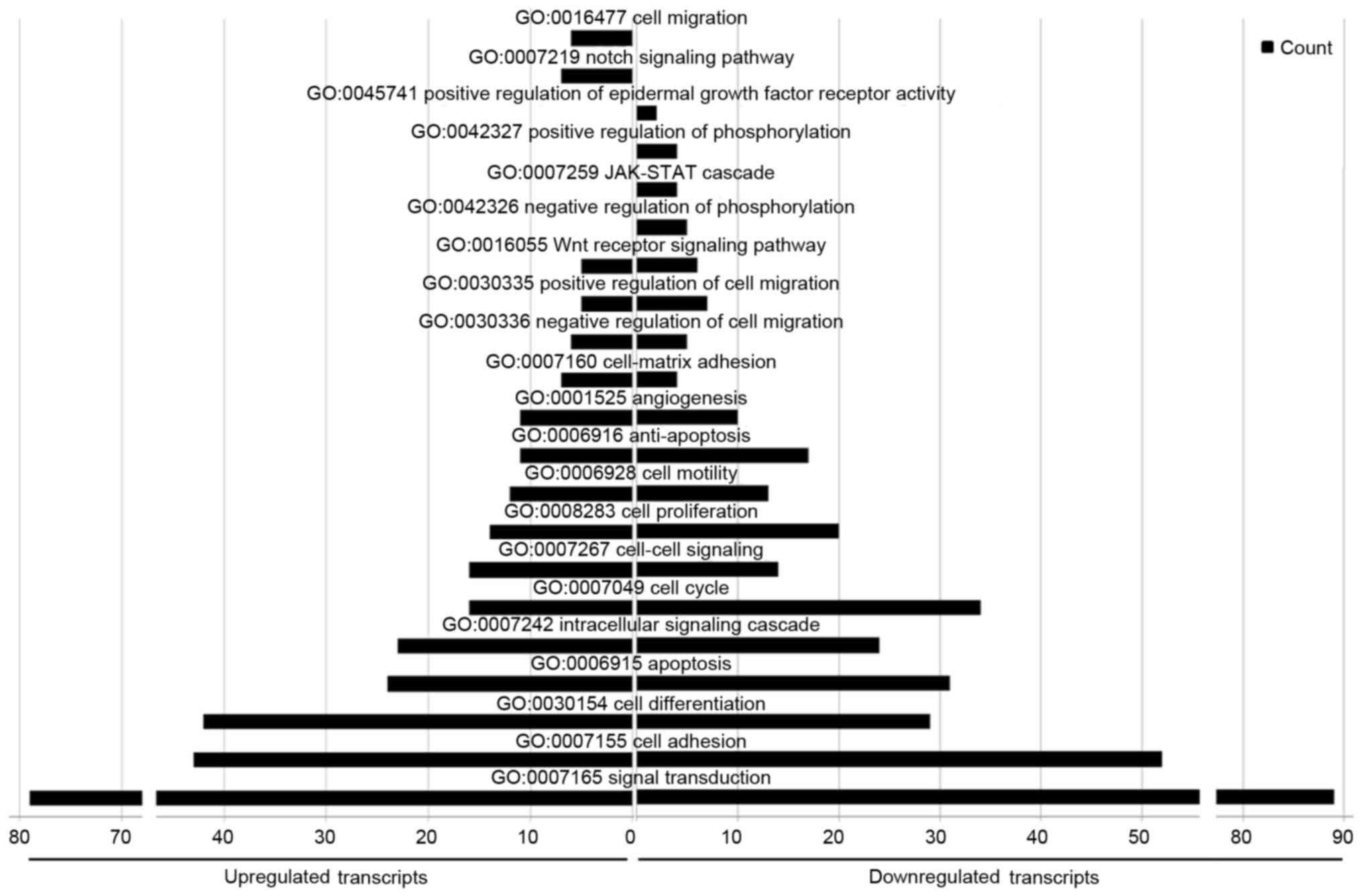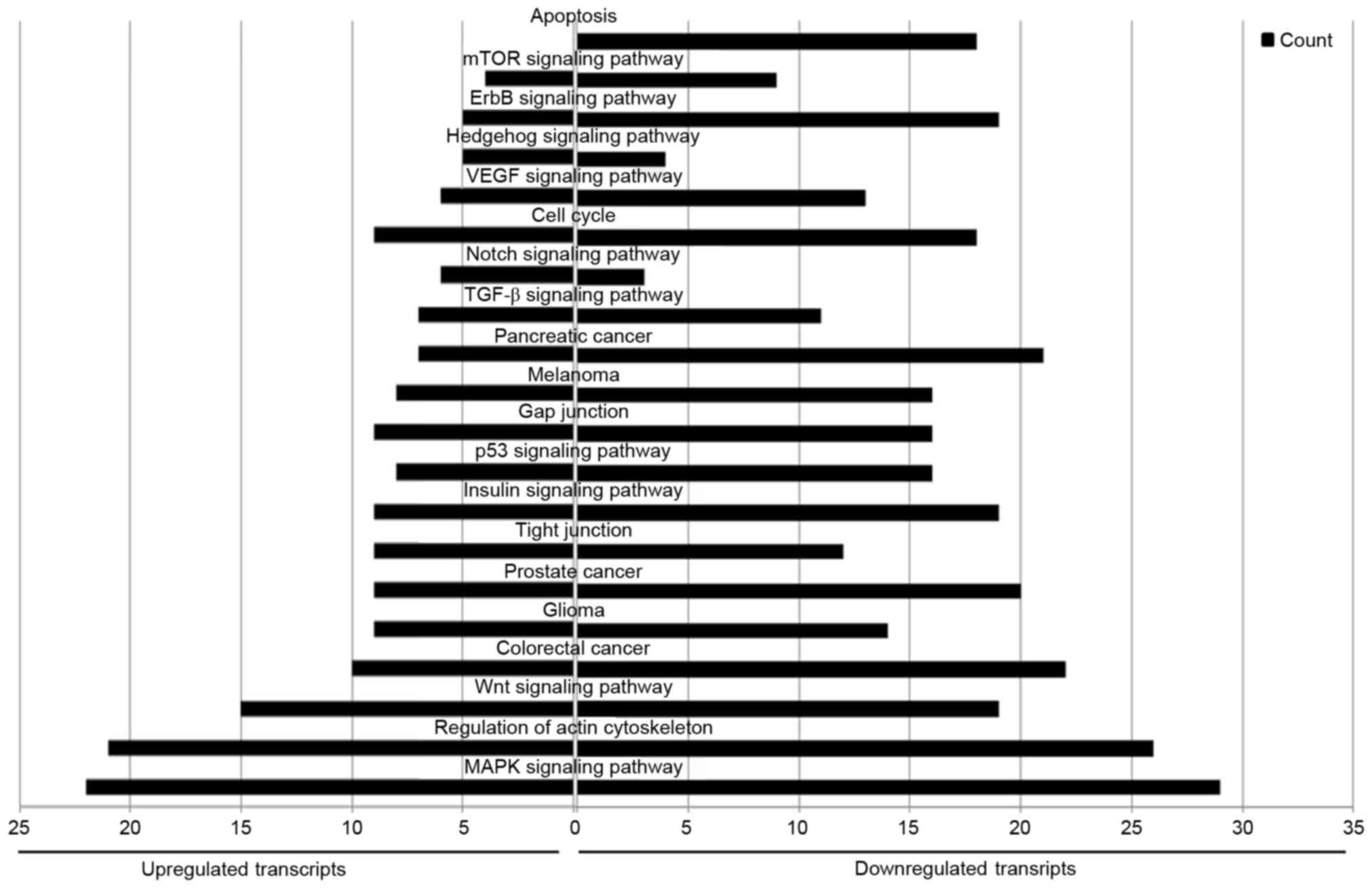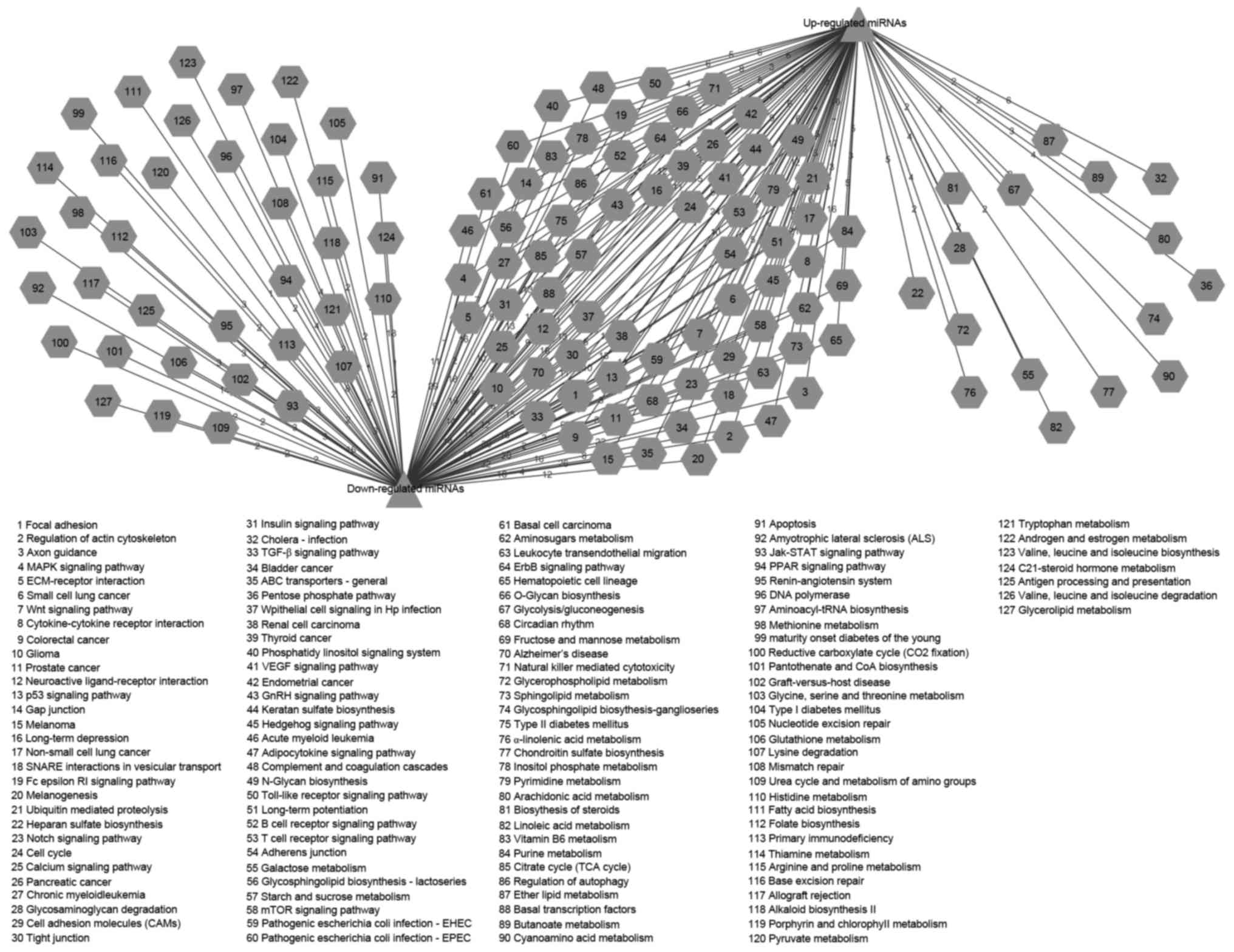|
1
|
Siegel R, Naishadham D and Jemal A: Cancer
statistics, 2013. CA Cancer J Clin. 63:11–30. 2013. View Article : Google Scholar : PubMed/NCBI
|
|
2
|
Parkin DM, Bray F, Ferlay J and Pisani P:
Global cancer statistics, 2002. CA Cancer J Clin. 55:74–108. 2005.
View Article : Google Scholar : PubMed/NCBI
|
|
3
|
Bandres E, Agirre X, Ramirez N, Zarate R
and Garcia-Foncillas J: MicroRNAs as cancer players: Potential
clinical and biological effects. DNA Cell Biol. 26:273–282. 2007.
View Article : Google Scholar : PubMed/NCBI
|
|
4
|
Baranwal S and Alahari SK: miRNA control
of tumor cell invasion and metastasis. Int J Cancer. 126:1283–1290.
2010.PubMed/NCBI
|
|
5
|
Nicoloso MS, Spizzo R, Shimizu M, Rossi S
and Calin GA: MicroRNAs-the micro steering wheel of tumour
metastases. Nat Rev Cancer. 9:293–302. 2009. View Article : Google Scholar : PubMed/NCBI
|
|
6
|
Iorio MV, Ferracin M, Liu CG, Veronese A,
Spizzo R, Sabbioni S, Magri E, Pedriali M, Fabbri M, Campiglio M,
et al: MicroRNA gene expression deregulation in human breast
cancer. Cancer Res. 65:7065–7070. 2005. View Article : Google Scholar : PubMed/NCBI
|
|
7
|
Volinia S, Calin GA, Liu CG, Ambs S,
Cimmino A, Petrocca F, Visone R, Iorio M, Roldo C, Ferracin M, et
al: A microRNA expression signature of human solid tumors defines
cancer gene targets. Proc Natl Acad Sci USA. 103:pp. 2257–2261.
2006; View Article : Google Scholar : PubMed/NCBI
|
|
8
|
Esquela-Kerscher A and Slack FJ:
Oncomirs-microRNAs with a role in cancer. Nat Rev Cancer.
6:259–269. 2006. View
Article : Google Scholar : PubMed/NCBI
|
|
9
|
Egami H, Takiyama Y, Cano M, Houser WH and
Pour PM: Establishment of hamster pancreatic ductal carcinoma cell
line (PC-1) producing blood group-related antigens. Carcinogenesis.
10:861–869. 1989. View Article : Google Scholar : PubMed/NCBI
|
|
10
|
Egami H, Tomioka T, Tempero M, Kay D and
Pour PM: Development of intrapancreatic transplantable model of
pancreatic duct adenocarcinoma in Syrian golden hamsters. Am J
Pathol. 138:557–561. 1991.PubMed/NCBI
|
|
11
|
Pour PM, Egami H and Takiyama Y: Patterns
of growth and metastases of induced pancreatic cancer in relation
to the prognosis and its clinical implications. Gastroenterology.
100:529–536. 1991. View Article : Google Scholar : PubMed/NCBI
|
|
12
|
Kozomara A and Griffiths-Jones S: miRBase:
Annotating high confidence microRNAs using deep sequencing data.
Nucleic Acids Res. 42(Database Issue): D68–D73. 2014. View Article : Google Scholar : PubMed/NCBI
|
|
13
|
Yang YH, Dudoit S, Luu P, Lin DM, Peng V,
Ngai J and Speed TP: Normalization for cDNA microarray data: A
robust composite method addressing single and multiple slide
systematic variation. Nucleic Acids Res. 30:e152002. View Article : Google Scholar : PubMed/NCBI
|
|
14
|
Tusher VG, Tibshirani R and Chu G:
Significance analysis of microarrays applied to the ionizing
radiation response. Proc Natl Acad Sci USA. 98:pp. 5116–5121. 2001;
View Article : Google Scholar : PubMed/NCBI
|
|
15
|
Yuan JS, Reed A, Chen F and Stewart CN Jr:
Statistical analysis of real-time PCR data. BMC Bioinformatics.
7:852006. View Article : Google Scholar : PubMed/NCBI
|
|
16
|
Kohl M, Wiese S and Warscheid B:
Cytoscape: Software for visualization and analysis of biological
networks. Methods Mol Biol. 696:291–303. 2011. View Article : Google Scholar : PubMed/NCBI
|
|
17
|
Kanehisa M and Goto S: KEGG: Kyoto
encyclopedia of genes and genomes. Nucleic Acids Res. 28:27–30.
2000. View Article : Google Scholar : PubMed/NCBI
|
|
18
|
Tan X, Egami H, Ishikawa S, Kurizaki T,
Nakagawa M, Hirota M and Ogawa M: Arrangement of expression and
distribution of tight junction protein claudin-1 in cell
dissociation of pancreatic cancer cells. Int J Oncol. 25:1567–1574.
2004.PubMed/NCBI
|
|
19
|
Tan X, Egami H, Ishikawa S, Kurizaki T,
Hirota M and Ogawa M: Zonula occludens-1 (ZO-1) redistribution is
involved in the regulation of cell dissociation in pancreatic
cancer cells. Dig Dis Sci. 50:1402–1409. 2005. View Article : Google Scholar : PubMed/NCBI
|
|
20
|
Tan X, Tamori Y, Egami H, Ishikawa S,
Kurizaki T, Takai E, Hirota M and Ogawa M: Analysis of
invasion-metastasis mechanism in pancreatic cancer: Involvement of
tight junction transmembrane protein occludin and MEK/ERK signal
transduction pathway in cancer cell dissociation. Oncol Rep.
11:993–998. 2004.PubMed/NCBI
|
|
21
|
Tan X, Egami H, Abe M, Nozawa F, Hirota M
and Ogawa M: Involvement of MMP-7 in invasion of pancreatic cancer
cells through activation of the EGFR mediated MEK-ERK signal
transduction pathway. J Clin Pathol. 58:1242–1248. 2005. View Article : Google Scholar : PubMed/NCBI
|
|
22
|
Tan X, Egami H, Ishikawa S, Sugita H,
Kamohara H, Nakagawa M, Nozawa F, Abe M and Ogawa M: Involvement of
matrix metalloproteinase-7 in invasion-metastasis through induction
of cell dissociation in pancreatic cancer. Int J Oncol.
26:1283–1289. 2005.PubMed/NCBI
|
|
23
|
Tan X, Egami H, Ishikawa S, Kurizaki T,
Tamori Y, Takai E, Hirota M and Ogawa M: Relationship between the
expression of extracellular signal-regulated kinase 1/2 and the
dissociation of pancreatic cancer cells: Involvement of ERK1/2 in
the dissociation status of cancer cells. Int J Oncol. 24:815–820.
2004.PubMed/NCBI
|
|
24
|
Tan X, Egami H, Kamohara H, Ishikawa S,
Kurizaki T, Yoshida N, Tamori Y, Takai E, Hirota M and Ogawa M:
Involvement of the mitogen-activated protein kinase kinase 2 in the
induction of cell dissociation in pancreatic cancer. Int J Oncol.
24:65–73. 2004.PubMed/NCBI
|
|
25
|
Tan X, Egami H, Ishikawa S, Nakagawa M,
Ishiko T, Kamohara H, Hirota M and Ogawa M: Relationship between
activation of epidermal growth factor receptor and cell
dissociation in pancreatic cancer. Int J Oncol. 25:1303–1309.
2004.PubMed/NCBI
|
|
26
|
Pour PM, Runge RG, Birt D, Gingell R,
Lawson T, Nagel D, Wallcave L and Salmasi SZ: Current knowledge of
pancreatic carcinogenesis in the hamster and its relevance to the
human disease. Cancer. 47 6 Suppl:S1573–S1589. 1981. View Article : Google Scholar
|
|
27
|
Ishikawa S, Egami H, Kurizaki T, Akagi J,
Tamori Y, Yoshida N, Tan X, Hayashi N and Ogawa M: Identification
of genes related to invasion and metastasis in pancreatic cancer by
cDNA representational difference analysis. J Exp Clin Cancer Res.
22:299–306. 2003.PubMed/NCBI
|
|
28
|
Zhao G, Wang B, Liu Y, Zhang JG, Deng SC,
Qin Q, Tian K, Li X, Zhu S, Niu Y, et al: miRNA-141, downregulated
in pancreatic cancer, inhibits cell proliferation and invasion by
directly targeting MAP4K4. Mol Cancer Ther. 12:2569–2580. 2013.
View Article : Google Scholar : PubMed/NCBI
|
|
29
|
Kadera BE, Li L, Toste PA, Wu N, Adams C,
Dawson DW and Donahue TR: MicroRNA-21 in pancreatic ductal
adenocarcinoma tumor-associated fibroblasts promotes metastasis.
PLoS One. 8:e719782013. View Article : Google Scholar : PubMed/NCBI
|
|
30
|
Yang TS, Yang XH, Wang XD, Wang YL, Zhou B
and Song ZS: MiR-214 regulate gastric cancer cell proliferation,
migration and invasion by targeting PTEN. Cancer Cell Int.
13:682013. View Article : Google Scholar : PubMed/NCBI
|
|
31
|
Zhao G, Zhang JG, Shi Y, Qin Q, Liu Y,
Wang B, Tian K, Deng SC, Li X, Zhu S, et al: MiR-130b is a
prognostic marker and inhibits cell proliferation and invasion in
pancreatic cancer through targeting STAT3. PLoS One. 8:e738032013.
View Article : Google Scholar : PubMed/NCBI
|
|
32
|
Chang TC, Wentzel EA, Kent OA,
Ramachandran K, Mullendore M, Lee KH, Feldmann G, Yamakuchi M,
Ferlito M, Lowenstein CJ, et al: Transactivation of miR-34a by p53
broadly influences gene expression and promotes apoptosis. Mol
Cell. 26:745–752. 2007. View Article : Google Scholar : PubMed/NCBI
|
|
33
|
Yang C and Wei W: The miRNA expression
profile of the uveal melanoma. Sci China Life Sci. 54:351–358.
2011. View Article : Google Scholar : PubMed/NCBI
|
|
34
|
Lee C, He H, Jiang Y, Di Y, Yang F, Li J,
Jin C and Fu D: Elevated expression of tumor miR-222 in pancreatic
cancer is associated with Ki67 and poor prognosis. Med Oncol.
30:7002013. View Article : Google Scholar : PubMed/NCBI
|
|
35
|
Kawaguchi T, Komatsu S, Ichikawa D,
Morimura R, Tsujiura M, Konishi H, Takeshita H, Nagata H, Arita T,
Hirajima S, et al: Clinical impact of circulating miR-221 in plasma
of patients with pancreatic cancer. Br J Cancer. 108:361–369. 2013.
View Article : Google Scholar : PubMed/NCBI
|















